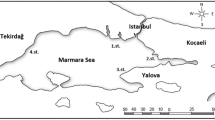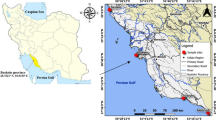Abstract
Concentrations of metals were determined in four species of anchovy (Coilia sp.) from the Yangtze River, Taihu Lake, and Hongze Lake in Jiangsu Province, China. Concentrations of Cr in anchovy fish muscle ranged from 2.6 × 10−2 to 5.0 mg/kg ww, and Coilia nasus taihuensis in Jiaoshan, Taihu Lake contained the highest concentrations of Cr, which was almost 111-fold higher than the mean value at other locations. Concentrations of Pb ranged from 1.5 × 10−2 to 1.3 × 10−1 mg/kg ww. Comparisons of concentrations of lead (Pb) among the four species indicated that anadromous species contained higher concentrations of Pb than did freshwater species. However, concentrations of Pb in C. nasus from the Nanjing and Haimen locations in the Yangtze River were not significant higher than those of two freshwater species: C. nasus taihuensis from Taihu Lake and C. brachygnathus from Hongze Lake (Duncan’s test, α = 0.05). While concentrations of Cd and Zn ranged from 7.0 × 10−4 to 3.6 × 10−3 mg/kg ww and 3.4 to 4.8 mg/kg ww, respectively, there were no significant differences in concentrations among the eight locations. The only concentration of the metals studied that exceeded the Chinese National Standard was Cr in Coilia from Jiaoshan, Taihu Lake, which was 2.5-fold higher than the standard. These results indicate that people who consume the genus Coilia are not at risk due to concentrations of metals, except Cr in C. nasus taihuensis from Jiaoshan in Taihu Lake. Concentrations of all of the metals studied except for Cr were similar to or less than those of metals in most other areas in the world.




Similar content being viewed by others
References
Al-Yousuf, M. H., El-Shahawi, M. S., & Al-Ghais, S. M. (2000). Trace metals in liver, skin and muscle of Lethrinus lentjan fish species in relation to body length and sex. The Science of the Total Environment, 256(2–3), 87–94. doi:10.1016/S0048-9697(99)00363-0.
Bennett, D. H., Kastenberg, W. E., & McKone, T. E. (1999). A multimedia, multiple pathway risk assessment of atrazine: the impact of age differentiated exposure including joint uncertainty and variability. Reliability Engineering & System Safety, 63(2), 185–198. doi:10.1016/S0951-8320(98)00046-5.
Burger, J., & Gochfeld, M. (2005). Heavy metals in commercial fish in New Jersey. Environmental Research, 99(3), 403–412. doi:10.1016/j.envres.2005.02.001.
Burger, J., Gochfeld, M., Jeitner, C., Burke, S., & Stamm, T. (2007). Metal levels in flathead sole (Hippoglossoides elassodon) and great sculpin (Myoxocephalus polyacanthocephalus) from Adak Island, Alaska: Potential risk to predators and fishermen. Environmental Research, 103(1), 62–69. doi:10.1016/j.envres.2006.02.005.
Chi, Q. Q., Zhu, G. W., & Langdon, A. (2007). Bioaccumulation of heavy metals in fishes from Taihu Lake, China. Journal of Environmental Sciences (China), 19(12), 1500–1504. doi:10.1016/S1001-0742(07)60244-7.
Chien, L. C., Hung, T. C., Choang, K. Y., Yeh, C. Y., Meng, P. J., Shieh, M. J., et al. (2002). Daily intake of TBT, Cu, Zn, Cd and As for fishermen in Taiwan. The Science of the Total Environment, 285(1–3), 177–185. doi:10.1016/S0048-9697(01)00916-0.
COMMISSION REGULATION (EC) No 1881/2006 of 19 December 2006 setting maximum levels for certain contaminants in foodstuffs. Official Journal of the European Union, L 364/5-24.
Cooper, C. B., Doyle, M. E., & Kipp, K. (1991). Risk of consumption of contaminated seafood, the Quincy Bay case study. Environmental Health Perspectives, 90, 133–140. doi:10.2307/3430857.
De Flora, S., Camoirano, A., Bagnasco, M., Bennicelli, C., Corbett, G. E., & Kerger, B. D. (1997). Estimates of the chromium (VI) reducing capacity in human body compartments as a mechanism for attenuating its potential toxicity and carcinogenicity. Carcinogenesis, 18(3), 531–537. doi:10.1093/carcin/18.3.531.
Feng, H., Han, X. F., Zhang, W. G., & Yu, L. Z. (2004). A preliminary study of heavy metal contamination in Yangtze River intertidal zone due to urbanization. Marine Pollution Bulletin, 49(11–12), 910–915. doi:10.1016/j.marpolbul.2004.06.014.
Fernandes, H. M., Bidone, E. D., Veiga, L. H. S., & Patchineelam, S. R. (1994). Heavy-metal pollution assessment in the coastal lagoons of Jacarepaguá, Rio de Janeiro, Brazil. Environmental Pollution, 85(3), 259–264. doi:10.1016/0269-7491(94)90046-9.
Fregert, S., & Gruvberger, B. (1972). Chemical properties of cement. Berufs-Dermatosen, 20(5), 238–245.
Klaassen, C. D. (2001). Casarett and Doull’s toxicology: The basic science of poisons. New York: The McGraw-Hill Companies, Inc.
Kwon, Y. T., & Lee, C. W. (2001). Ecological risk assessment of sediment in wastewater discharging area by means of metal speciation. Microchemical Journal, 70(3), 255–264. doi:10.1016/S0026-265X(01)00122-9.
Licata, P., Trombetta, D., Cristani, M., Martino, D., & Naccari, F. (2004). Organochlorine compounds and heavy metals in the soft tissue of the mussel Mytilus galloprovincialis collected from Lake Faro (Sicily, Italy). Environment International, 30(6), 805–810. doi:10.1016/j.envint.2004.01.007.
Newman, M. C., & Unger, M. A. (2003). Fundamentals of ecotoxicology. Boca Raton: CRC Press LLC.
Nriagu, J. O., & Pacyna, J. M. (1988). Quantitative assessment of worldwide contamination of air, water, and soils by trace metals. Nature, 333, 134–139. doi:10.1038/333134a0.
Pan, Q., Zhang, L. Q., Gao, Q. H., Huang, Z., & Wang, B. (2001). China National Standard, Safety qualification for agricultural product- Safety requirements for non-environmental pollution aquatic products, GB18406.4.
Perone, V. B., Moffitt, A. A., Possick, P. A., Key, M. M., Danzinger, S. J., & Gellin, G. A. (1974). The chromium, cobalt, and nickel contents of American cement and their relationship to cement dermatitis. American Industrial Hygiene Association Journal, 35(5), 301–306. doi:10.1080/0002889748507038.
Robson, M. (2003). Methodologies for assessing exposures to metals: Human host factors. Ecotoxicology and Environmental Safety, 56(1), 104–109. doi:10.1016/S0147-6513(03)00054-X.
Shen, D. (1994). Human activities and water area eco-environments. In H. Sund & Y. Xiaogan (Eds.), Environmental protection and lake ecosystem. Proceedings of an International Symposium held in Wuxi from March 27 to April 1, 1993 (pp. 167–180). Beijing, China: China Science and Technology Press.
Shen, G. Q., Lu, Y. T., Wang, M. N., & Sun, Y. Q. (2005). Status and fuzzy comprehensive assessment of combined heavy metal and organo-chlorine pesticide pollution in the Taihu Lake region of China. Journal of Environmental Management, 76(4), 355–362. doi:10.1016/j.jenvman.2005.02.011.
Tang, W. Q., Hu, X. L., & Yang, J. Q. (2007). Species validities of Coilia brachygnathus and C. nasus taihuensis based on sequence variations of complete mtDNA control region. Biodiversity Science, 15(3), 224–231. doi:10.1360/biodiv.060263.
Tuan, C., & Ng, L. F. (2007). The place of FDI in China’s regional economic development: Emergence of the globalized delta economies. Journal of Asian Economics, 18(2), 348–364. doi:10.1016/j.asieco.2007.02.005.
US EPA (1987) Cadmium. Washington, D.C.: US Environmental Protection Agency CASRN: 7440-43-9. http://www.epa.gov/NCEA/iris/subst/0141.htm.
US EPA (1989) Guidance manual for assessing human health risks from chemically contaminated, fish and shellfish. Washington, D.C., US Environmental Protection Agency EPA-503/8-89-002.
US EPA (1998a) Toxicological review of Hexavalent Chromium. Washington, D.C., U.S. Environmental Protection Agency CASRN: 18540-29-9.
US EPA (1998b) Toxicological review of Trivalent Chromium. Washington, D.C., U.S. Environmental Protection Agency CASRN: 16065-83-1.
US EPA (2004) Lead and compounds (inorganic). Washington, D.C., U.S. Environmental Protection Agency CASRN: 7439-92-1. http://www.epa.gov/NCEA/iris/subst/0277.htm.
US EPA (2005) Toxicological review of Zinc and compounds. Washington, D.C., U.S. Environmental Protection Agency EPA-635/R-05-002.
Wang, X. L., Sato, T., Xing, B. S., & Tao, S. (2005). Health risks of heavy metals to the general public in Tianjin, China via consumption of vegetables and fish. Science of the Total Environment, 350(1–3), 28–37.
Wang, H., Wang, C. X., Wang, Z. J., et al. (2004). Fractionation of heavy metals in surface sediments of Taihu Lake, East China. Environmental Geochemistry and Health, 26, 303–309.
WHO. (1992). Cadmium, World Health Organization. International Programme on Chemical Safety, Environmental Health Criteria 135. http://www.inchem.org/documents/ehc/ehc/ehc135.htm.
WHO. (1995). Inorganic Lead, World Health Organization. International Programme on Chemical Safety, Environmental Health Criteria 165. http://www.inchem.org/documents/ehc/ehc/ehc165.htm.
WHO. (2001). Zinc, World Health Organization. International Program on Chemical Safety, Environmental Health Criteria 221. http://www.inchem.org/documents/ehc/ehc/ehc221.htm.
Wu, Q. L., Han, C., Yang, H. F., Wang, H. Z., Gu, W. Q., & Tian, Y. B. (1994a). China National Standard, Tolerance limit of cadmium in foods, GB 15201-94.
Wu, Q. L., Wang H. Z., Gu, W. Q., Hu, X., & Su, Y. (1994b). China National Standard, Tolerance limit of lead in foods, GB 14935-94.
Xu, J. N., Sun, C. B., Tong, Y. R., & Tao, J. Y. (1978). The biological indicator of the spawning migration on anchovy in Yangtze River. Journal of Nanjing University (Natural Sciences), 3, 85–91. (in Chinese).
Yang, Z., Wang, H., Saito, Y., Milliman, J. D., Xu, K., Qiao, S., et al. (2006). Dam impacts on the Changjiang (Yangtze) River sediment discharge to the sea: the past 55 years and after the Three Gorges Dam. Water Resources Research, 42, 04407–04417.
Yang, R. Q., Yao, T. D., Xu, B. Q., Jiang, G. B., & Xin, X. D. (2007). Accumulation features of organochlorine pesticides and heavy metals in fish from high mountain lakes and Lhasa River in the Tibetan Plateau. Environment International, 33(2), 151–156.
Yuan, B. J., Pan, X. Q., Dai, Y., & Shi, Z. M. (2007). Study on transition of dietary pattern in Jiangsu Province. Acta Nutrimenta Sinica, 29(6), 569–572.
Acknowledgements
This study was financially supported by Jiangsu Science and Technology Department (BM2006503), Jiangsu Ocean and Fishery Department (K2006-3), and Department of Personnel Jiangsu (07-G-028) China. The authors wish to thank Hao Chen, Tang Zhebing, Chao Ping, Zhang Shengyu, Gu Shuxing, Huang Ping, Li Bing, and Li Gonghai, who helped with sampling and conducting the residue analyses. Prof. Giesy was supported as an at large Chair Professorship from the Department of Biology and Chemistry and Research Centre for Coastal Pollution and Conservation, City University of Hong Kong and by an “Area of Excellence” Grant (AoE P-04/04) from the Hong Kong University Grants Committee. The research was supported by a Discovery Grant from the National Science and Engineering Research Council of Canada (Project #6807) support of an instrumentation grant from the Canada Foundation for Infrastructure.
Author information
Authors and Affiliations
Corresponding author
Rights and permissions
About this article
Cite this article
Liu, F., Ge, J., Hu, X. et al. Risk to humans of consuming metals in anchovy (Coilia sp.) from the Yangtze River Delta. Environ Geochem Health 31, 727–740 (2009). https://doi.org/10.1007/s10653-009-9258-1
Received:
Accepted:
Published:
Issue Date:
DOI: https://doi.org/10.1007/s10653-009-9258-1




